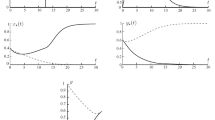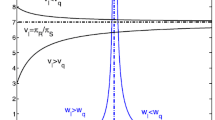Abstract
A system of differential equations for the control of tumor cells growth in a cycle nonspecific chemotherapy is presented. Spontaneously acquired drug resistance is accounted for, as well as the evolution in time of normal cells. In addition, optimization of conflicting objectives forms the aim of the chemotherapeutic treatment. For general cell growth, some results are given, whereas for the special case of Malthusian (exponential) growth of tumor cells and rather general growth rate for normal cells, the optimal strategy is worked out. The latter, from the clinical standpoint, corresponds to maximum drug concentration throughout the treatment.
Similar content being viewed by others
References
Coldman, A. J. and J. H. Goldie. 1983. A model for the resistance of tumor cells to cancer chemotherapeutic agents.Math. Biosci. 65, 291–307.
Coldman, A. J. and J. H. Goldie. 1986. A stochastic model for the origin and treatment of tumors containing drug-resistant cells.Bull. Math. Biol. 48, 279–292.
Costa, M. I. S., J. L. Boldrini and R. C. Bassanezi. 1992. Optimal chemical control of populations developing drug resistance.IMA J. Math. Appl. Med. Biol. 9, 215–226.
Costa, M. I. S., J. L. Boldrini and R. C. Bassanezi. 1994. Optimal chemotherapy: a case study with drug resistance, saturation effect and toxicity.IMA J. Math. Appl. Med. Biol. 11, 45–59.
Costa, M. I. S., J. L. Boldrini and R. C. Bassanezi. 1995a. Drug kinetics and drug resistance in optimal chemotherapy.Math. Biosc. 125, 191–209.
Costa, M. I. S., J. L. Boldrini and R. C. Bassanezi. 1995b. Chemotherapeutic treatments involving drug resistance and level of normal cells as a criterion of toxicity.Math. Biosci. 125, 211–228.
Costa, M. I. S. and J. L. Boldrini. 1997. Chemotherapeutic treatments: a study of the interplay among drug resistance, toxicity and recuperation from side effects. Unpublished manuscript.
Eisen, M. 1978.Mathematical in Cell Biology and Cancer Chemotherapy. Lecture Notes in Biomathematics, Vol. 30. Heidelberg: Springer-Verlag.
Goldie, J. H. and A. J. Coldman. 1979. A mathematical model for relating the drug sensitivity of tumors to their spontaneous mutation rate.Cancer Treat. Rep. 63, 1727–1733.
Harnevo, L. and Z. Agur. 1992. Drug resistance as a dynamic process in a model for multistep gene amplification under various levels of selection stringency.Cancer Chemother. Pharmacol. 30, 469–476.
Kirk, D. 1970.Optimal Control Theory. Englewood Cliffs, NJ: Prentice-Hall.
Leitmann, G. 1974.Cooperative and Non-Cooperative Many Player Differential Games, International Centre for Mechanical Sciences Course Lectures, No. 190. Udine, Italy: Springer-Verlag.
Murray, J. M. 1990a. Optimal control for a cancer chemotherapy problem with general growth and loss functions.Math. Biosci. 98, 273–287.
Murray, J. M. 1990b. Some optimal control problems in cancer chemotherapy with a toxicity limit.Math. Biosci. 100, 49–67.
Murray, J. M. 1995. An example of the effects of drug resistance on the optimal schedule for a single drug in cancer chemotherapy.IMA J. Math. Appl. Med. Biol. 12, 55–71.
Skipper, H. E. 1983. The forty year old mutation theory of Luria and Delbruck and its pertinence to cancer chemotherapy.Adv Cancer Research 40, 331–363.
Swan, G. W. and T. L. Vincent. 1977. Optimal control analysis in the chemotherapy ofI g G multiple myeloma.Bull. Math. Biol. 39, 317–337.
Swan, G. W. 1987. Tumor growth models and cancer chemotherapy. InCancer Modeling, J. R. Thompson and B. W. Brown (Eds), pp. 91–179 New York: Marcel Dekker.
Swan, G. W. 1990. Role of optimal control theory in cancer chemotherapy.Math. Biosc. 101, 237–284.
Vaidya, V. G. and F. J. Alexandro, Jr. 1982. Evaluation of some mathematical models for tumor growth.Int. J. Bio-Med. Comp. 13, 19–35.
Vendite, L. L. 1988.Modelagem matemática para o crescimento tumoral e o problema de resistência celular aos fármacos anti-blásticos. Ph.D. thesis, Faculdade de Engenharia Elétrica, Universidade Estadual de Campinas, SP, Brazil.
Zietz, S. and C. Nicolini. 1979. Mathematical approaches to optimization of cancer chemotherapy.Bull. Math. Biol. 41, 305–324.
Author information
Authors and Affiliations
Rights and permissions
About this article
Cite this article
Costa, M.I.S., Boldrini, J.L. Conflicting objectives in chemotherapy with drug resistance. Bltn Mathcal Biology 59, 707–724 (1997). https://doi.org/10.1007/BF02458426
Received:
Revised:
Issue Date:
DOI: https://doi.org/10.1007/BF02458426




